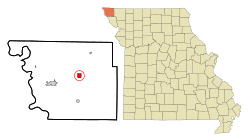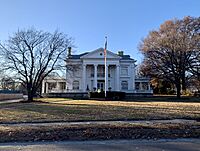Tarkio, Missouri facts for kids
Quick facts for kids
Tarkio, Missouri
|
|
|---|---|
|
Mansion in Tarkio
|
|

Location of Tarkio, Missouri
|
|
| Country | |
| State | |
| County | Atchison |
| Township | Tarkio |
| Area | |
| • Total | 1.39 sq mi (3.59 km2) |
| • Land | 1.39 sq mi (3.59 km2) |
| • Water | 0.00 sq mi (0.00 km2) |
| Elevation | 997 ft (304 m) |
| Population
(2020)
|
|
| • Total | 1,506 |
| • Density | 1,085.80/sq mi (419.32/km2) |
| Time zone | UTC−6 (Central (CST)) |
| • Summer (DST) | UTC−5 (CDT) |
| ZIP code |
64491
|
| Area code(s) | 660 |
| FIPS code | 29-72340 |
| GNIS feature ID | 2396032 |
Tarkio is a city in Atchison County, Missouri, United States. It is part of Tarkio Township. In 2020, about 1,506 people lived there.
Tarkio was officially started in 1880. It became an incorporated city in 1881. The name "Tarkio" comes from the Meskwaki language. It means "place where walnuts grow."
Contents
History of Tarkio
Tarkio was founded by Charles E. Perkins in 1880. The city grew very quickly. By 1900, the U.S. Census showed 2,845 people living in Tarkio. For the next 30 years, the number of residents stayed about the same.
One famous building in Tarkio was the Tarkio Mule Barn. It was a unique, eight-sided brick building. It was built in the early 1890s. Later, it became the Tarkio Mule Barn Theatre. Tarkio College used it for performances. This building was even on the National Register of Historic Places. Sadly, a fire destroyed it in 1989.
Two other important buildings are still standing. Rankin Hall and the Walnut Inn are also listed on the National Register of Historic Places. This means they are important historical sites.
Geography and Climate
Tarkio is located in Missouri. According to the United States Census Bureau, the city covers about 1.39 square miles (3.59 square kilometers). All of this area is land.
The weather in Tarkio changes throughout the year. Summers are warm, and winters are cold. The city gets rain and some snow.
| Climate data for Tarkio, Missouri (1981–2010) | |||||||||||||
|---|---|---|---|---|---|---|---|---|---|---|---|---|---|
| Month | Jan | Feb | Mar | Apr | May | Jun | Jul | Aug | Sep | Oct | Nov | Dec | Year |
| Mean daily maximum °F (°C) | 34.9 (1.6) |
40.6 (4.8) |
50.7 (10.4) |
64.6 (18.1) |
74.3 (23.5) |
81.9 (27.7) |
86.2 (30.1) |
84.8 (29.3) |
77.9 (25.5) |
66.2 (19.0) |
50.6 (10.3) |
36.9 (2.7) |
62.5 (16.9) |
| Mean daily minimum °F (°C) | 15.3 (−9.3) |
19.4 (−7.0) |
28.4 (−2.0) |
39.4 (4.1) |
51.3 (10.7) |
60.5 (15.8) |
65.4 (18.6) |
61.4 (16.3) |
53.1 (11.7) |
41.4 (5.2) |
29.7 (−1.3) |
18.9 (−7.3) |
40.4 (4.7) |
| Average precipitation inches (mm) | 0.50 (13) |
1.10 (28) |
2.08 (53) |
2.60 (66) |
4.95 (126) |
4.16 (106) |
4.52 (115) |
3.41 (87) |
3.06 (78) |
2.54 (65) |
1.91 (49) |
1.03 (26) |
31.87 (809) |
| Average snowfall inches (cm) | 3.9 (9.9) |
4.4 (11) |
2.6 (6.6) |
0.9 (2.3) |
0.0 (0.0) |
0.0 (0.0) |
0.0 (0.0) |
0.0 (0.0) |
0.0 (0.0) |
0.1 (0.25) |
0.8 (2.0) |
3.0 (7.6) |
15.5 (39) |
| Source: NOAA | |||||||||||||
People of Tarkio
| Historical population | |||
|---|---|---|---|
| Census | Pop. | %± | |
| 1890 | 1,156 | — | |
| 1900 | 1,901 | 64.4% | |
| 1910 | 1,966 | 3.4% | |
| 1920 | 1,870 | −4.9% | |
| 1930 | 2,016 | 7.8% | |
| 1940 | 2,114 | 4.9% | |
| 1950 | 2,221 | 5.1% | |
| 1960 | 2,160 | −2.7% | |
| 1970 | 2,517 | 16.5% | |
| 1980 | 2,375 | −5.6% | |
| 1990 | 2,243 | −5.6% | |
| 2000 | 1,935 | −13.7% | |
| 2010 | 1,583 | −18.2% | |
| 2020 | 1,506 | −4.9% | |
| U.S. Decennial Census | |||
2010 Census Information
In 2010, there were 1,583 people living in Tarkio. These people lived in 703 households. About 421 of these were families.
Most people in Tarkio were White (97.9%). A small number were African American (0.8%), Native American (0.4%), or Asian (0.4%). Some people were of two or more races (0.4%). About 1.0% of the population was Hispanic or Latino.
About 25% of households had children under 18 living there. Many households (46.9%) were married couples. About 35% of all households had only one person living in them. The average age of people in Tarkio was about 45.9 years old.
Education in Tarkio
Tarkio is part of the Tarkio R-I School District. This district provides public education for students in the area.
Tarkio was once home to Tarkio College. This was a private college founded in 1883. It was connected to the Presbyterian Church. The college closed its doors in 1991.
However, a new educational effort began later. In 2012, the college's alumni (former students) started renting the main building, Rankin Hall. In 2019, a new school called Tarkio Technology Institute (TTI) opened. TTI offers special training courses. These courses help people get certifications in areas like plumbing, wind energy, and welding.
Public Library
The Tarkio Branch Library is a local library. It is part of the Atchison County Library system.
Famous People from Tarkio
Many interesting people have connections to Tarkio.
- Wallace Hume Carothers (1896–1937) was a scientist. He studied at Tarkio College. He later taught at Harvard University. Carothers is known as the "father of man-made polymers." He discovered important materials like nylon and neoprene.
- Edgar Lee Hewett (1865–1946) was an anthropologist. He also studied at Tarkio College. He helped create the Antiquities Act. This law helps protect important historical and archaeological sites in the United States. He became the first president of the New Mexico Normal School.
- Walter Greene (1910–1983) was a music composer. He was born in Tarkio. He is famous for his work on cartoons. He composed music for shows like The Pink Panther Show and The Inspector.
- David Rankin (1825–1910) was known as the "Missouri Corn King." He lived in Tarkio. He started with a small farm and grew it into a huge one. He owned over 25,000 acres of land. He also raised many cattle and hogs. Rankin used new tools and technology to grow a million bushels of corn in one year. Rankin Hall at the former Tarkio College was named after his family.
- Sam Graves is a U.S. Representative. This means he is a politician who helps make laws for the country. He is from Tarkio. His brother, Todd Graves, was also a public official. He was a U.S. Attorney for Western Missouri.
- The music group Brewer & Shipley named their album Tarkio. They also have a song called Tarkio Road. They named these after a place where they often played music in Tarkio.
See also
 In Spanish: Tarkio (Misuri) para niños
In Spanish: Tarkio (Misuri) para niños


